Related Research Articles
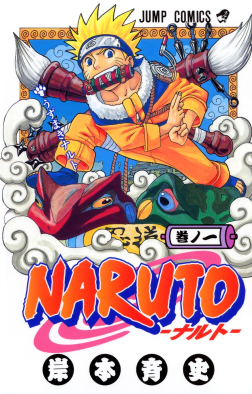
Naruto is a Japanese manga series written and illustrated by Masashi Kishimoto. It tells the story of Naruto Uzumaki, a young ninja who seeks recognition from his peers and dreams of becoming the Hokage, the leader of his village. The story is told in two parts: the first is set in Naruto's pre-teen years, and the second in his teens. The series is based on two one-shot manga by Kishimoto: Karakuri (1995), which earned Kishimoto an honorable mention in Shueisha's monthly Hop Step Award the following year, and Naruto (1997).

Ehrgeiz, fully titled Ehrgeiz: God Bless the Ring, is a 3D fighting video game developed by DreamFactory and published by Namco in 1998 for the arcade platform. It was first ported to the PlayStation and published by Square Co. in 1998, then to Japan's PlayStation Network by Square Enix in 2008.

Naruto Uzumaki is the titular protagonist of the manga Naruto, created by Masashi Kishimoto. He is a ninja from the fictional Hidden Leaf Village. As a boy, Naruto is ridiculed and ostracized on account of the Nine-Tailed Demon Fox—a malevolent creature that attacked Konohagakure—that was sealed away in his body. Despite this, he aspires to become his village's leader, the Hokage, in order to receive their approval. His carefree, optimistic, and boisterous personality enables him to befriend other Konohagakure ninja, as well as ninja from other villages. Naruto appears in the series' films and in other media related to the franchise, including video games and original video animations (OVA), as well as the sequel Boruto: Naruto Next Generations, where he is the Hokage, and his son, Boruto Uzumaki, is the protagonist.
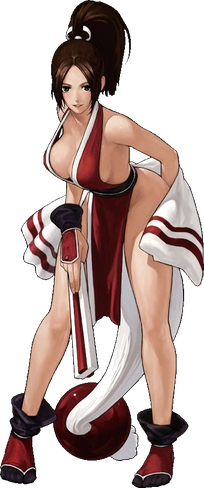
Mai Shiranui is a character in the Fatal Fury and The King of Fighters series of fighting games by SNK. Introduced in 1992's Fatal Fury 2, the character was originally conceived as a male character named "Ninja Master", but when a request was put in to include a female character in the game they revised the concept entirely. For the game's sequel Fatal Fury 3 they considered replacing her with another female character, but due to heavy fan request she returned instead and has been a frequent character in both the Fatal Fury and King of Fighters series since.
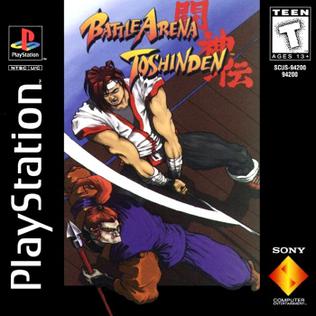
Battle Arena Toshinden is a fighting video game developed by Tamsoft and published by Takara for the PlayStation. Originally released in 1995, it was released internationally by Sony Computer Entertainment, followed by 1996 ports for the Sega Saturn, Game Boy and MS-DOS. It was one of the first fighting games, after Virtua Fighter in 1993 on arcade and console, to boast polygonal characters in a 3D environment, and features a sidestep maneuver which is credited for taking the genre into "true 3D."

Pokémon: Destiny Deoxys is a 2004 Japanese anime film directed by Kunihiko Yuyama. It is the seventh film in the Pokémon series and the second film released under Pocket Monsters Advance Generation in Japan. The film stars the voices of Rica Matsumoto, Ikue Otani, Yuji Ueda, Kaori, Fushigi Yamada, Noriko Hidaka, Koichi Yamadera, Susumu Chiba, Kenji Nojima, and Becky. The events of the film take place during the seventh season of Pokémon: Advanced Challenge.

Rock Lee is a fictional character in the anime and manga series Naruto and Naruto Shippuden created by Masashi Kishimoto. At first Masashi designed Lee to symbolize human strength. In the anime and manga, Lee is a ninja affiliated with the village of Konohagakure, and is a member of Team Guy, which consists of himself, Neji Hyuga, Tenten, and Might Guy—the team's leader. Unable to use most ninja techniques, Lee dedicates himself to using solely taijutsu, ninja techniques similar to martial arts. Lee dreams of becoming a "splendid ninja" despite his inabilities. Lee has appeared in several pieces of Naruto media, including the third and fourth featured films in the series, the third original video animation, and multiple video games.
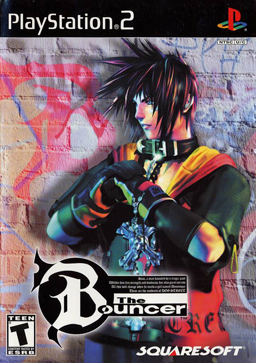
The Bouncer is a 2000 beat 'em up video game for the PlayStation 2 co-developed by Squaresoft and DreamFactory. It was published in Japan by Squaresoft in December 2000, in North America by Square Electronic Arts in March 2001, and in Europe by Sony Computer Entertainment Europe in June 2001. The game was produced by Shinji Hashimoto, co-directed by Takashi Tokita and Seiichi Ishii, and features character designs by Tetsuya Nomura, and music by Noriko Matsueda and Takahito Eguchi.
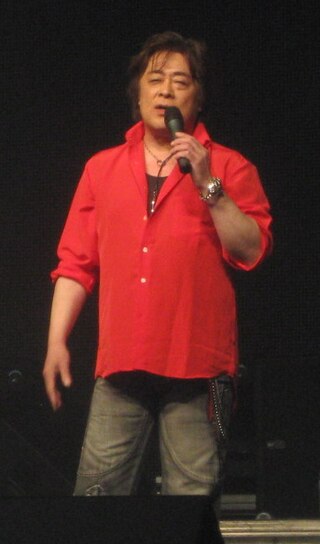
Takayuki Miyauchi, is a Japanese singer best known for his work on theme songs for tokusatsu and anime. A resident of Ibaraki Prefecture, he began his career as founding member and lead vocalist of the band "WHY" in 1981 before making his solo debut in 1984, singing the opening theme for the "Super Sentai" tokusatsu television series Choudenshi Bioman.
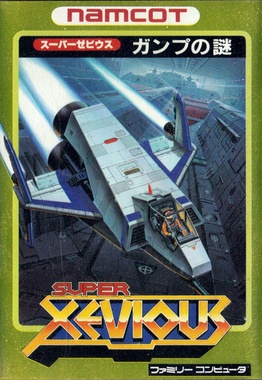
Super Xevious: GAMP no Nazo is a 1986 vertically scrolling shooter video game developed and published by Namco for the Family Computer in Japan. It is the sequel to Xevious, a popular arcade game released in late 1982, and the fourth installment in the Xevious franchise overall. The player controls a spaceship named the Solvalou in its mission to destroy a powerful supercomputer named GAMP, which took over Earth during an ice age. GAMP no Nazo features a heavy focus on puzzle-solving, with each of the game's 21 levels posing a puzzle that must be solved to progress.
Seiichi Ishii is a Japanese game designer. He is best known for the development of fighting games.

Naruto Shippuden: Ultimate Ninja Storm Revolution, known in Japan as Naruto Shippūden: Narutimate Storm Revolution, is a fighting video game developed by CyberConnect2 and published by Bandai Namco Games as part of the Naruto: Ultimate Ninja video game series, based on the manga Naruto by Masashi Kishimoto. The game was released in September 2014 in Japan, North America, and Europe for the PlayStation 3 and Xbox 360.

Naruto Shippuden: Ultimate Ninja Storm 4, known in Japan as Naruto Shippūden: Narutimate Storm 4, is a fighting game developed by CyberConnect2 and published by Bandai Namco Entertainment for PlayStation 4, Xbox One, and Windows in February 2016. It is the sixth installment and the final main installment of the Naruto: Ultimate Ninja Storm series inspired by Masashi Kishimoto's manga Naruto, and the sequel to the 2013 game Naruto Shippuden: Ultimate Ninja Storm 3 Full Burst. It was also the first Naruto video games released for PlayStation 4 and Xbox One.
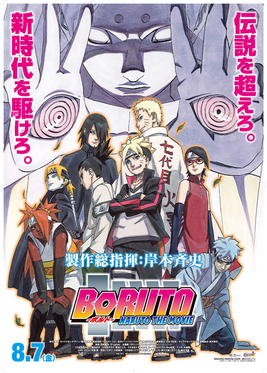
Boruto: Naruto the Movie is a 2015 Japanese animated martial arts fantasy film and the directorial debut of Hiroyuki Yamashita. It is based on Masashi Kishimoto's manga and anime Naruto, and is the second film to be a part of the canonical Naruto storyline, being a sequel to the manga series. It stars Yūko Sanpei, Junko Takeuchi, Kokoro Kikuchi and Noriaki Sugiyama. Set after the finale of Naruto, the film focuses on the title character Boruto Uzumaki, son of Naruto's protagonist, Naruto Uzumaki, who cannot stay with his family due to being the leader of his ninja village. Vigilante Sasuke Uchiha returns to the village with warnings about two beings who might become a big threat to the world peace the ninjas managed to bring about in the original series.

Hiroshi Matsuyama, born in November 23, 1970 in Fukuoka, is a Japanese game designer. He is the CEO of the company CyberConnect2. He developed multiple games including the .hack franchise as well as adaptations of the anime series including Naruto and Dragon Ball. Besides developing games, Matsuyama has participated in directing two .hack films as well as voicing a character from the series.
References
- 1 2 3 "Company Profile". DreamFactory.
- ↑ DreamFactory | 会社沿革
- ↑ "Thread: kenju(atomiswave)". Archived from the original on 2013-01-17. Retrieved 2012-12-26.
- ↑ CAPCOM FINDING ALLSTARS.:拳獣 - livedoor Blog(ブログ)
- ↑ 拳獣 -KENJU-
- ↑ "Arcadia 0053". October 2004.
- ↑ Spencer (June 26, 2009). "Ehrgeiz Developers Working On Toshinden Revival". Siliconera.com. Retrieved 2009-06-28.
- ↑ タカラトミーゲーム情報局